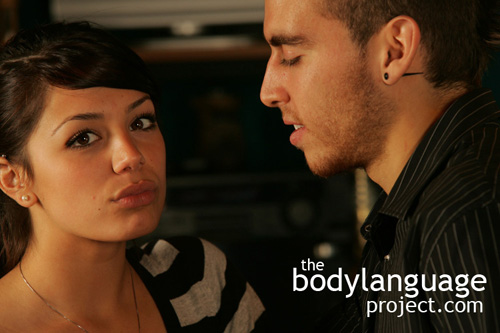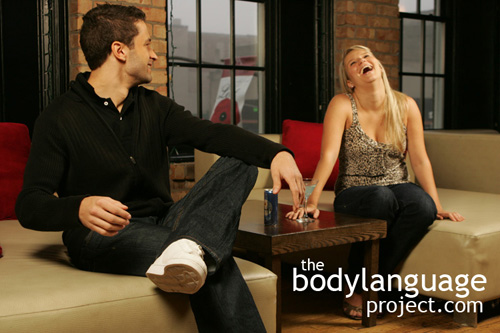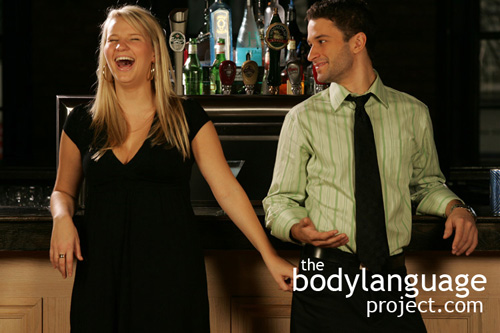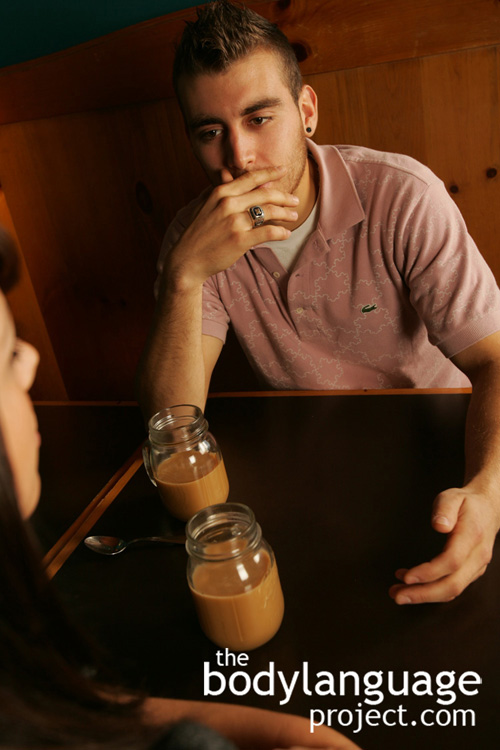Body Language of Interlaced Fingers
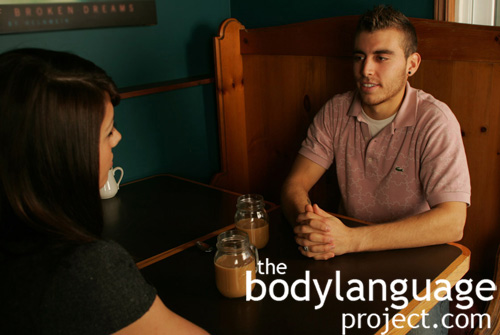
 Cue: Interlaced Fingers
Cue: Interlaced Fingers
Synonym(s): Entwined Fingers, Interlocking Fingers.
Description: When the fingers are interlocked or interlaced together. They are sometimes rubbed together in order to provide a pacifying effect.
In One Sentence: Interlaced fingers are an indication of frustration, hostility, self-restraint and other negative thoughts.
How To Use it: Interlaced fingers can be used to help steady nervous hands. By locking them together, it will provide security and comfort. This sign goes mostly unnoticed by others so it is unlikely that they will read your frustration, instead confusing it with self-control.
If possible, however, one should try to keep the fingers unlocked to demonstrate confidence.
Context: General.
Verbal Translation: “My fingers are interlaced together because I’m holding frustration, hostility and other negative thoughts. I need to entwine my fingers so I keep them under careful restrained control.”
Variant: See Hand Clasping.
Cue In Action: a) The defendant waited patiently on stand as he was cross-examined. His fingers interlaced neatly on his lap. On closer inspection, one could see his fingers moving up and down and his knuckles tightly pressed together.
b) The junior associate made sure he was obedient while the senior ranking member said his piece. He interlocked his hands on his lap and sat quietly so as not to disturb the presentation. Once the floor was opened up to the rest of the associates, the junior associate unlocked his fingers and began to gesticulate as he showed the various shortcomings in the plan.
Meaning and/or Motivation: This gesture is commonly thought as a contained and controlled posture, but this is not so. This gesture reveals frustration, hostility and that a person is harbouring negative thoughts.
When the fingers massage the palm or the fingers are interlaced then gently rub up and down as the fingers stroke the inside of the other, it indicates a person who is in doubt, has low confidence, or is experiencing stress. As tension escalates, the gesture will move from palm stroking into more rigorous interlaced finger stroking making the two a progression of intensity. Thus while palm stroking is due to mild doubt or slight confidence issues, interlaced fingers that rub up and down is to do a higher level of anxiety.
As conversations intensify watch for increases in soothing body language revealing the underlying anxiety. The gesture feels comfortable to do because it closes up the body from the outside world preventing the hands from speaking (gesturing).
If the thumbs dart up while the fingers are interlaced it can turn a timid interlaced fingers gesture into a positive cue. Thumbs-out is a representation of ego, dominance, confidence, comfort, assertiveness and sometimes even aggressiveness.
At times the fingers may become interlaced appearing as if in prayer, which might even be the case. Pressure can be so great that the fingers can even blanch as blood flow is impeded.
Cue Cluster: Watch for adjoining cues to amplify the level of stress, anxiety or discomfort. For example, compressed lips, neck scratching and fidgeting might signal a desire to interject. Thumbs up gestures while sitting back might signal dominance through a relaxed stance. There can be many motivations behind interlaced fingers and the associated cues will help the body language reader decide the true meaning.
Body Language Category: Clenching and gripping, Masked emotions, Pacifying body language.
Resources:
Atkinson A, Dittrich W, Gemmell A, Young A. Emotion perception from dynamic and static body expressions in point-light and full-light displays. Perception 2004;33:717–46.
Aviezer H, Trope Y, Todorov A. Body cues, not facial expressions, discriminate between intense positive and negative emotions. Science 2012;338:1225–9.
Allen, Jill; Sarah J. Gervais and Jessi L. Smith. Sit Big to Eat Big: The Interaction of Body Posture and Body Concern on Restrained Eating. Psychology of Women Quarterly 2013. 37(3): 325-336. DOI: 10.1177/0361684313476477pwq.sagepub.com
http://bodylanguageproject.com/articles/sit-big-to-eat-big-how-constrictive-postures-reduce-food-consumption/
Arnette, S. L., & Pettijohn, T. F., II. (2012). The effects of posture on self-perceived leadership. International Journal of Business and Social Science, 3, 8–13.
Bohns, Vanessa K. and Scott S. Wiltermuth. It Hurts When I Do This (Or You Do That): Posture And Pain tolerance. Journal of Experimental Social Psychology. 2012. 48: 341-345.
http://bodylanguageproject.com/articles/dominant-and-submissive-postures-affects-more-than-public-perception-it-also-affects-felt-pain-and-physical-strength/
Briñol, P., Petty, R. E., & Wagner, B. (2009). Body posture effects on self-evaluation: A self-validation approach. European Journal of Social Psychology, 39, 1053–1064.
Borenstein, Lynn. The development of friendship in childhood: A clinical conversation. Child and Adolescent Social Work Journal. 1996. 13(3): 213-224.
Bodie, Grahamd. ; Villaume, Williama. Men and Women Holding Hands Revisited: Effects of Mutual Engagement and Hand Dominance on Attributions of Cross-Sex Handholding. Communication Research Reports. 2008. 25(4): 243-254.
Barroso, Felix ; Feld, Jason. Self-touching and attentional processes: The role of task difficulty, selection stage, and sex differences. Journal of Nonverbal Behavior. 1986. 10(1): 51-64.
Butzen, Nathan David ; Bissonnette, Victor ; Mcbrayer, Dan. Effects of modeling and topic stimulus on self-referent touching. Perceptual and motor skills. 2005. 101(2): 413-20.
Broome, Marion E.. Helping Parents Support Their Child In Pain. Pediatric Nursing. 2000. 26(3): 315.
Bernal, Gilda Rios ; Wortham, Suec. How to Calm Children through Massage. Childhood Education. 1997. 74(1): 9-14.
Bouhuys, A.L. ; Jansen, C.J. ; van den Hoofdakker, R.H. Analysis of observed behaviors displayed by depressed patients during a clinical interview: relationships between behavioral factors and clinical concepts of activation. Journal of Affective Disorders. 1991. 21(2): 79-88.
Blidstein, Gerald J. The Nonverbal Language of Prayer (review).Shofar: An Interdisciplinary Journal of Jewish Studies. 2007 25(2): 195-196.
Chapell, M ; Basso, E ; Decola, A ; Hossack, J ; Keebler, J ; Marm, J ; Reed, B ; Webster, E ; Yoggev, D. Men and women holding hands: whose hand is uppermost?
Perceptual and motor skills. 1998. 87(1):127-30
Cowen, Emory L. ; Weissberg, Roger P. ; Lotyczewski, Bohdan S. Garfield, Sol L. (editor). Physical contact in interactions between clinicians and young children. Journal of Consulting and Clinical Psychology. 1983. 51(1): 132-138.
Cashdan, Elizabeth. Smiles, Speech, and Body Posture: How Women and Men Display Sociometric Status and Power. Journal of Nonverbal Behavior. 1998. 22(4): 209-228.
Carney, Dana R.; Amy J.C. Cuddy; Andy J. Yap. Power Posing: Brief Nonverbal Displays Affect Neuroendocrine Levels and Risk Tolerance. Psychological Science, 2010; 21 (10): 1363-1368.
http://bodylanguageproject.com/articles/benefits-power-posing-high-stakes-performance/
Cesario, J., & McDonald, M. M. (2013). Bodies in context: Power poses as a computation of action possibility. Social Cognition, 31, 260–274.
Cuddy, Amy J.C., Caroline A. Wilmuth, and Dana R. Carney. The Benefit of Power Posing Before a High-Stakes Social Evaluation. Harvard Business School Working Paper, No. 13-027, September 2012.
http://bodylanguageproject.com/articles/benefits-power-posing-high-stakes-performance/
D’alessio, M. ; Zazzetta, A. Development of Self-Touching Behavior in Childhood. Perceptual and Motor Skills. 1986. 63(1): 243-253.
Ekman P, Friesen W. Head and body cues in judgement of emotion—a reformulation. Percept Mot Skill 1967;24:711–24.
Flores, Luis E. ; Berenbaum, Howard. Desire for emotional closeness moderates the effectiveness of the social regulation of emotion. Personality and Individual Differences
Fischer, Julia; Peter Fischer; Birte Englich; Nilüfer Aydin and Dieter Frey. Empower My Decisions: The Effects of Power Gestures on Confirmatory Information Processing. Journal of Experimental Social Psychology. 2011. 47: 1146-1154.
http://bodylanguageproject.com/articles/downside-power-posing-body-language-looking-power-posing-action-study/
http://bodylanguageproject.com/articles/benefits-power-posing-high-stakes-performance/
Gulledge, Andrewk. ; Gulledge, Michelleh. ; Stahmannn, Robertf.. Romantic Physical Affection Types and Relationship Satisfaction. The American Journal of Family Therapy. 2003. 31(4): 233-242.
Gulledge, Andrew K ; Stahmann, Robert F ; Wilson, Colwick M. Seven types of nonsexual romantic physical affection among Brigham young university students. Psychological reports. 2004. 95(2): 609-14.
Goldberg, Shelly ; Rosenthal, Robert. Self-touching behavior in the job interview: Antecedents and consequences. Journal of Nonverbal Behavior. 1986. 10(1): 65-80.
Huang, L., Galinsky, A. D., Gruenfeld, D. H., & Guillory, L. E. (2011). Powerful postures versus powerful roles: Which is the proximate correlate of thought and behavior? Psychological Science, 22, 95–102.
Harrigan, Jinni A. Self-touching as an indicator of underlying affect and language processes. Social Science & Medicine. 1985. 20(11): 1161-1168.
Harrigan, Jinni A.; Karen S. Lucic; Denise Kay; Anne McLaney and Robert Rosenthal. Effect of Expresser Role and Type of Self-Touching on Observers’ Perceptions. Journal of Applied Social Psychology. 1991. 21(7): 585-609.
Hung, Iris W. and Aparna A. Labroo. From Firm Muscles to Firm Willpower: Understanding the Role of Embodied Cognition in Self-Regulation. Journal of Consumer Research. 2011 37(6): 1046-1064. http://www.jstor.org/stable/10.1086/657240
http://bodylanguageproject.com/articles/firm-muscles-lead-willpower/
Karagozoglu, Serife ; Kahve, Emine. Effects of back massage on chemotherapy-related fatigue and anxiety: Supportive care and therapeutic touch in cancer nursing. Applied Nursing Research. 2013. 26(4): 210-217.
Lehman, E.B., Holtz, B.A., & Aikey, K.L. (1995). Temperament and self-soothing behaviour in children: Object attachment, thumbsucking, and pacifier use. Early Education and Development, 6(1), 53–72.
Laird, J. D., & Lacasse, K. (2014). Bodily influences on emotional feelings: Accumulating evidence and extensions of William James’s theory of emotion. Emotion Review, 6, 27–34.
Lee, E. H., & Schnall, S. (2014). The influence of social power on weight perception. Journal of Experimental Psychology: General, 143, 1719–1725.
Maestripieri D, Schino G, Aureli F, Troisi A. 1992. A modest proposal: displacement activities as an indicator of emotions in primates. Anim Behav 44:967–979.
Mohiyeddini, C., Bauer, S., & Semple, S. (2013a). Displacement behaviour is associated with reduced stress levels among men but not women. PLoS One, 8, e56355.
Mohiyeddini, C., Bauer, S., & Semple, S. (2013b). Public self-consciousness moderates the link between displacement behaviour and experience of stress in women. Stress, 16, 384–392.
Mohiyeddini, C., & Semple, S. (2013). Displacement behaviour regulates the experience of stress in men. Stress, 16, 163–171.
Michalak, J., Mischnat, J., & Teismann, T. (2014). Sitting posture makes a difference: Embodiment effects on depressive memory bias. Clinical Psychology & Psychotherapy, 21, 519–524.
Minvaleev, R. S., Nozdrachev, A. D., Kir’yanova, V. V., & Ivanov, A. I. (2004). Postural influences on the hormone level in healthy subjects: I. The cobra posture and steroid hormones. Human Physiology, 30, 452–456.
Nair, S., Sagar, M., Sollers, J., III, Consedine, N., & Broadbent, E. (2014). Do slumped and upright postures affect stress responses? A randomized trial. Health Psychology. Advance online publication. doi:10.1037/hea0000146
O’sullivan, Lucia F. ; Cheng, Mariah Mantsun ; Harris, Kathleen Mullan ; Brooks-gunn, Jeanne. I Wanna Hold Your Hand: The Progression of Social, Romantic and Sexual Events in Adolescent Relationships. Perspectives on Sexual and Reproductive Health. 2007. 39(2): 100-107.
Park, Lora E.; Lindsey Streamer; Li Huang and Adam D. Galinsky. Stand Tall, But Don’t Put Your Feet Up: Universal and Culturally-Specific Effects of Expansive Postures On Power. Journal of Experimental Social Psychology. 2013; 49: 965–971.
http://bodylanguageproject.com/articles/are-expansive-postures-of-power-universal-or-cultural/
Pettijohn, Terry F. , Ii ; Ahmed, Shujaat F. ; Dunlap, Audrey V. ; Dickey, Lauren N. Who’s got the upper hand? Hand holding behaviors among romantic couples and families.(Report). Current Psychology. 2013. 32(3): 217(4).
Rosenbloom, Tova ; Ben-Eliyahu, Adar ; Nemrodov, Dan. Children’s crossing behavior with an accompanying adult. Safety Science. 2008. 46(8): 1248-1254.
Rubin, Mark Morrison, Todd G. (editor). Social Affiliation Cues Prime Help-Seeking Intentions. Canadian Journal of Behavioural Science/Revue canadienne des sciences du comportement. 2011. 43(2): 138-141.
Ranehill, Eva; Anna Dreber; Magnus Johannesson; Susanne Leiberg; Sunhae Sul and Roberto A. Weber. Assessing the Robustness of Power Posing: No Effect on Hormones and Risk Tolerance in a Large Sample of Men and Women. Psychological Science, March, 2015. doi: 10.1177/0956797614553946 http://bodylanguageproject.com/articles/power-posing-no-effect-hormones-amy-cuddy-wrong/
Riskind, J. H. (1984). They stoop to conquer: Guiding and selfregulatory functions of physical posture after success and failure. Journal of Personality and Social Psychology, 47, 479–493.
Riskind, J. H., & Gotay, C. C. (1982). Physical posture: Could it have regulatory or feedback effects on motivation and emotion? Motivation and Emotion, 6, 273–298.
Stepper, S., & Strack, F. (1993). Proprioceptive determinants of emotional and nonemotional feelings. Journal of Personality and Social Psychology, 64, 211–220.
Strelan, P., Weick, M., & Vasiljevic, M. (2013). Power and revenge. British Journal of Social Psychology, 53, 521–540.
Schwartz, B., Tesser, A., & Powell, E. (1982). Dominance cues in nonverbal behavior. Social Psychology Quarterly, 45, 114–120.
Stepper, S., & Strack, F. (1993). Proprioceptive determinants of emotional and nonemotional feelings. Journal of Personality and Social Psychology, 64, 211–220.
Schenkel, Rudolf. Submission: Its Features and Function in the Wolf and Dog. American Zoologist. 1967. 7(2): 319-329.
Toronto, Ellen L.K. A clinician’s response to physical touch in the psychoanalytic setting. International Journal of Psychotherapy. 2002 7(1): 69-81.
Troisi A. 1999. Ethological research in clinical psychiatry: the study of nonverbal behaviour during interviews. Neurosci Biobehav Rev 23:905–913.
Troisi A. 2002. Displacement activities as a behavioral measure of stress in nonhuman primates and human subjects. Stress 5: 47–54.
Tiedens, Larissa Z ; Fragale, Alison R. Power moves: complementarity in dominant and submissive nonverbal behavior. Journal of personality and social psychology. 2003. 84(3): 558-68.
Tracy, J. L., & Robins, R. W. (2004). Show your pride: Evidence for a discrete emotion expression. Psychological Science, 15, 194–197.
Tiedens, Larissa Z. and Alison R. Fragale. Power Moves: Complementarity in Dominant and Submissive Nonverbal Behavior. Journal of Personality and Social Psychology. 2003, 84(3): 558–568.
http://bodylanguageproject.com/articles/power-posing-no-effect-hormones-amy-cuddy-wrong/
Williams, Trish ; Connolly, Jennifer ; Cribbie, Robert. Light and Heavy Heterosexual Activities of Young Canadian Adolescents: Normative Patterns and Differential Predictors.(Author abstract)(Report). Journal of Research on Adolescence. 2008. 18(1): 145(28).
Walsh, Joseph ; Eccleston, Christopher ; Keogh, Edmund. Pain communication through body posture: The development and validation of a stimulus set. Pain. 2014. 155(11): 2282-2290.
Welker, K. M., Oberleitner, D. E., Cain, S., & Carré, J. M. (2013). Upright and left out: Posture moderates the effects of social exclusion on mood and threats to basic needs. European Journal of Social Psychology, 43, 355–361.
Yap, Andy J. Abbie S. Wazlawek, Brian J. Lucas, Amy J. C. Cuddy, Dana R. Carney. The Ergonomics of Dishonesty: The Effect of Incidental Posture on Stealing, Cheating, and Traffic Violations, 24(11); 2281-2289.
http://bodylanguageproject.com/articles/body-posture-physical-environment-determine-feelings-and-behaviour-study/


